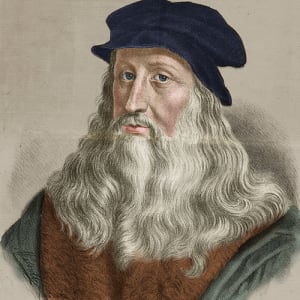Madrid was the “capital of technical and scientific knowledge of the Golden Age”, a time when Leonardo da Vinci’s codices reached the capital, whose history is the backbone of the exhibition Ingenuity at the service of power. The codices of Leonardo da Vinci in the Austrian court, which opens today at the Royal Academy of Fine Arts of San Fernando.
“The common thread of this exhibition is a story that is little known and that is worth discovering; how at the end of the 16th century almost everything that Leonardo Da Vinci wrote arrived in Madrid”, Magoga Piñas, one of the curators of the exhibition during its inauguration, which was attended by the Minister of Culture and Tourism, Marta Rivera de la Cruz.
Under the name Ingenuity at the service of power. The codices of Leonardo da Vinci in the court of the Austrias, the General Directorate of Cultural Heritage of the Ministry of Culture and Tourism of the Community of Madrid, in collaboration with the Royal Academy of Fine Arts of San Fernando, where the sample is exhibited , organize this exhibition available until May 16, recovering the “little known Spanish Golden Age of science and technology”.
A century in which Madrid was positioned as the “capital of technical and scientific knowledge” and in which “great projects of architecture and civil initiative” took place, in addition to hosting the renowned codices of Leonardo da Vinci, brought by the Milanese architect Pompeo Leoni at the end of the 16th century, and coinciding with the stay in Madrid of the “elite of the engineers of the time”, to whom it could have served as “inspiration”.
“Pompeo Leoni brought the codices to Madrid, and although the exact number is unknown, they could have been close to twenty. When he died, his heirs dispersed them, but almost all the documentation on machinery that we have seen throughout history created by da Vinci , was one day here “, the curator details about the codices, highlighting the importance of keeping two of the originals, the Madrid I-II codices, in the National Library of Madrid.
The exhibition, according to Piña detail, answers the question of why the codices reached the capital; “The codices arrived in Madrid because it was the center of Europe’s technology,” she remarks. There, they were able to read them renowned engineers, giving rise to “indications that propose that many works could be inspired by their content,” she explains, adding that the exhibition “may help other researchers” to continue investigating.
With the presence of these manuscripts by Leonardo da Vinci in the Madrid of the great engineers, the exhibition proposes a journey through the technology of this part of history, whose content is divided into six blocks, containing from theoretical books to hydraulic projects or the project of the work of the Monastery of San Lorenzo de El Escorial.
“It is a multidisciplinary exhibition that tells a story”, Piñas reels about the content, of which pieces such as The Twenty-One Books of the Sugar Mills and Machines stand out – technical publication with measurement systems and hydraulic devices of the time – scientific instruments used during these centuries, or two sculptures attributed to Pompeo Leoni.
This sample of objects composed “exclusively of original content” is complemented by a digital montage, which recreates in 3D copies made from the 16th to the 18th century, such as the study of the fight of a lion with a dragon, a reputed da Vinci work belonging to the volumes in the Valparaíso collection and that “it could be the oldest surviving copy of the lost original.”
With pieces gathered thanks to the collaboration of more than twenty institutions, including the Prado Museum, the National Archaeological Museum, the San Fernando Royal Academy of Fine Arts and the Turin Library, among others, the exhibition invites you to do this “travel in time” knowing the technological discoveries of the time.
Nicolás García Tapias, Elisa Ruiz, Daniel Crespo, Almudena Pérez de Tudela, Mariano Esteban Piñeiro, Magoga Piñas, and Almudena Palancar make up the multidisciplinary group of curators of the exhibition, experts in areas such as engineering, mathematics or history that give rise to to this exhibition that brings the technological advances of the time closer to the viewer.

